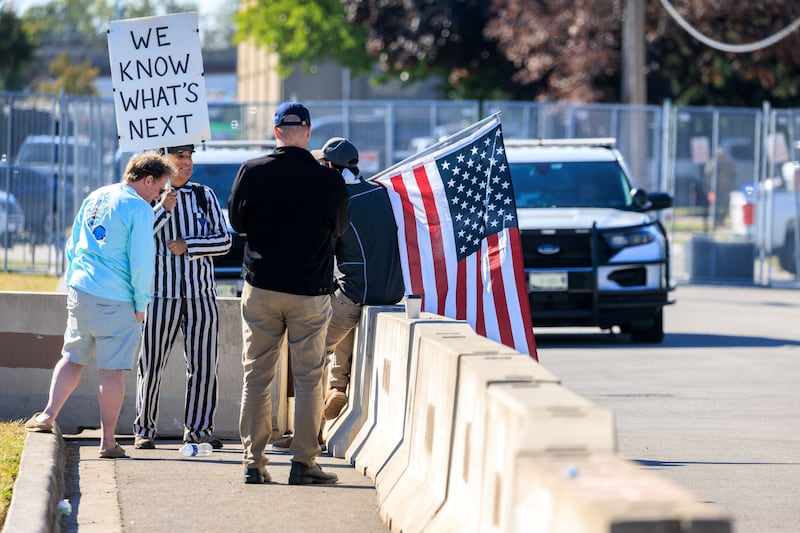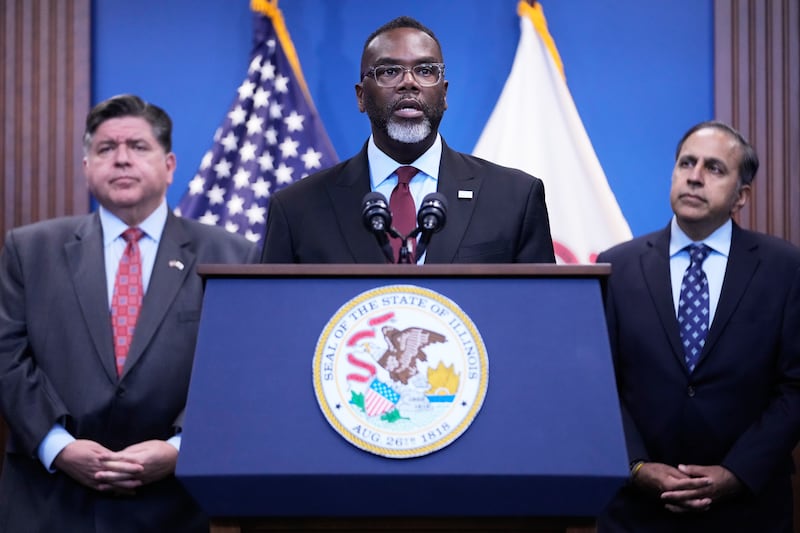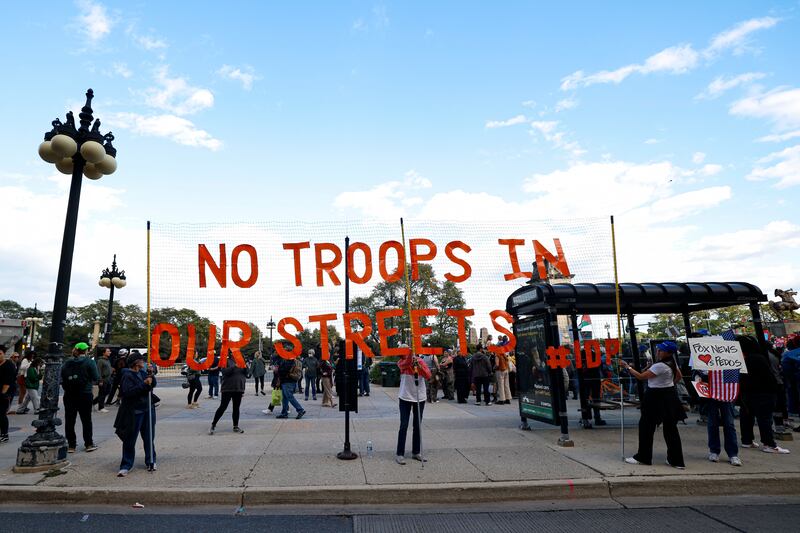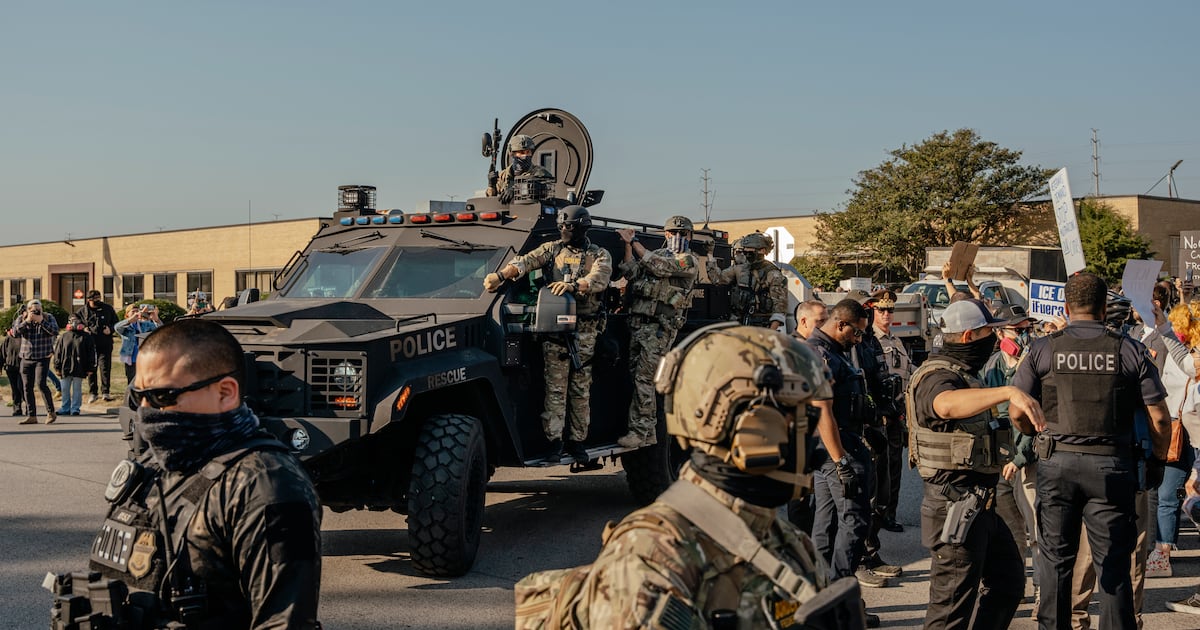It’s been more than a fortnight since the Tamale Lady was lifted by Ice. Laura Murillo, a fixture in the Back of the Yards neighbourhood of Chicago for two decades, had acquired a localised fame for the quality of her sweet and savoury masa dough snacks.
She is 51, a single mother. Immigration agents arrived when she was setting up her stall at the usual spot shortly after 7.30am. A Reddit post later declared: Tamale Lady was taken on 47th and western. “Masked guys took her away, left her cart and van. I’m gonna miss her she was a very nice lady.”
That is the way it has been in Chicagoland since: rumours and sudden snatchings and protests and, from the White House, ominous threats from president Donald Trump and other administration members that the city – with a population of three million – is a “war zone”.
For weeks, the president had been hinting at sending the national guard to Chicago, a city for which he reserves a special animus. On Monday evening, Texas governor Gregg Abbott posted a photograph of several national guardsmen boarding an aircraft and flying north. “God Speed,” he wrote.
Then, on Thursday, US district judge April Perry temporarily blocked the Trump administration from deploying the national guard in Illinois, following more than two hours of arguments from lawyers for the federal government and the state of Illinois. The order took effect on Thursday and will remain in place for two weeks, with the judge reportedly saying she had “seen no credible evidence that there is a danger of a rebellion in the state of Illinois”.
For those of us in downtown Chicago, the apocalyptic reports from leading figures from the administration – Pam Bondi, Kash Patel – made for a delirious contrast with the late-afternoon scenario. The last of the season’s tourists ambled around Michigan and East Wacker, stopping for photographs in front of the imperious, gleaming tower that bears the surname, in huge silver capitals, of the president of the United States. Joggers moved along the river walk, past the bronze statue Irv Kupcinet, the beloved Sun-Times columnist, besuited and with a copy of the paper tucked under his pocket as he hails someone.
If this was a war zone, it was news to the shoppers, the diners at outdoor riverside cafes, the canoeists in the dusk on the river and the commuters on those iconic red metal bridges that run along Wabash and State while locals chit-chatted about the sudden drop of temperatures. “It’s real Fall, not fake Fall,” said one passerby. No, this section of Chicago read more like the dreamy brochure for Trump towers that David Axelrod, one of the city’s Democratic grandees, scathingly read aloud on a CNN news show on Tuesday night.
But that’s not to say a war, of sorts, has not broken out. On Thursday morning, president Trump dropped a breezy opinion on Truth Social about the city’s mayor, as well as governor of Illinois JB Pritzker.
“Chicago Mayor should be in jail for failing to protect Ice Officers! Governor Pritzker also!”
Trump was referencing one of the several flashpoints between civilian protests and the Ice agents who have become an increasingly visible, heavy presence over the past month.
On Saturday a 31-year-old woman, Marimar Martinez, was shot five times by Ice agents after allegedly ramming an agent’s vehicle. Already, the woman’s attorney is arguing that body-count video evidence directly contradicts the agents’ claims that they were acting in self-defence.
 Protesters stand outside the Ice detention facility in Broadview, Illinois. Photograph: Cristobal Herrera-Ulashkevich/EPA
Protesters stand outside the Ice detention facility in Broadview, Illinois. Photograph: Cristobal Herrera-Ulashkevich/EPA
Alderwoman Julia Ramirez was in her 12th Ward Office on South Archer Street when the incident happened and she arrived about 15 minutes later.
“I did see a lot of people being detained,” she says when we meet at her office on Wednesday afternoon. “They brought tanks, tear gas. We already had rapid responders on the ground and people had seen agents hop out of their cars with guns drawn. We had heard something about a shooting and a crash, and I was really sceptical.
“But when I arrived, I sincerely thought this would be a 30-minute process and it ended up becoming a six to eight hour event. Every 10 minutes, more troops would come. It was just slowly escalating and it was causing a lot of tension. And I think they needed to create this image of chaos. And the next day is when Trump announced he was deploying the national guard.”
McKinley and Brighton Park are neighbourhoods that serve as a living history to Chicago’s constantly evolving immigrant story. Until the late 1960s they were steadfastly Polish and Lithuanian.
Ramirez’s parents moved from Mexico to nearby Pilsen in the 1970s and over the following decades, the ward became predominantly Latino in ethnicity – although she says that older Polish-Americans still return to worship at the local Catholic church.
South Archer Avenue is a long, sprawling strip of low-slung buildings – car repair shops and local cafes, pet-boarding facilities, a Family Dollar grocery shop near the metro line. Ramirez is the first ever woman to be elected to the 12th ward of Chicago city council.
She describes how a summer long campaign to educate locals in how to deal with approaches from Ice officers became overwhelmed by the “Midway Blitz” announcement, which initiated a dramatic escalation in the number of swoop-and-scoop type operations through which detainees are bought to Broadview, the Ice detention facility, which has been the other chief flashpoint between protesters and civilians.
“It was very pronounced,” she says of the rise in activity. “Agents are just picking people up off the street. We have a Home Depot here at an intersection near a high school and they usually stage there in the mornings and then branch out. We see days where people are getting detained on every block for a couple of miles. It all happens really fast. And there is more aggression in their approach and how they are grabbing people.”
We are going to push back and defend Chicago and all American cities against this tyrant
— Chicago’s mayor Brandon Johnson
When Chicagoans are arrested by Ice, they are brought to the Broadview facility in the northwest of the city. Sarah, who preferred to withhold her surname, is among those who has been protesting outside the centre over the past few weeks. In the beginning, there were no barriers so people could protest on the street outside. Metal fencing has since pushed them back.
“It was a gradual progression in terms of the federal government or Ice escalating,” she says. “When the protests started, there were no barriers. People could protest on the street outside.
“Then the barriers went up and it slowly escalated to the point that we had tear gas used on us, we were pepper-bombed. An Ice agent shot into a window of a building across from us, arbitrarily. They were firing at press and people alike – there were one or two photographers who were fired at indiscriminately for crossing an arbitrary line.”
The use of chemical and physical force and actual bullets has both shocked and enraged Chicagoans. One Broadview protester was struck in the head by a pepper ball fired by an Ice agent standing on the roof. He was David Black, a pastor from the First Presbyterian Church in Woodlawn.
But the Trump administration is arguing that it is trying to save a city from itself and has highlighted the number of proven immigrant gang members it has detained.
FBI director Kash Patel made a fleeting visit to Chicago on Tuesday and quoted the statistic of 1,200 shootings in 2025 alone, with 360 homicides already. “When I was there today with Todd [Blanche] we learned that the Chicago city streets have 110,000 gang members.” That statistic has been quoted before and has been interrogated: other estimates suggest about 35,000 active gang members.
But Patel’s figures contain a broader truth about Chicago’s enduring and shockingly high murder rate. Chicago has been plagued with staggering levels of gun violence for decades. What it doesn’t communicate is that the vast majority of those murders are essentially segregated; confined to the communities of the southside, shamefully neglected for decades, where young black men and young Latino men are killing other young black men and Latino men.
The plan to send in the national guard on Monday evening is a symbol of Trump’s vow to make Chicago “safe” again, by imposing two distinct outside entities: the Ice agents and military troops from Texas.
 Chicago mayor Brandon Johnson. Photograph: Nam Y Huh/AP
Chicago mayor Brandon Johnson. Photograph: Nam Y Huh/AP
In response, Chicago’s mayor Brandon Johnson has signed a series of executive orders guaranteeing the right to protest in the city and prohibiting Ice agents from operating on city property.
“Ice cannot prepare its weapons on school parking lots. Ice cannot prepare to disappear families in the parking lots of libraries,” he said this week.
“That is not what these accommodations are for. We literally had a south side neighbourhood under siege with Blackhawk helicopters where individuals who were sleeping peacefully in their communities had masked armed men stick long guns in their faces.
“This is not the type of America that our ancestors fought long and hard to create. It is a fundamental attack on our democracy. It is not about immigration; it is not about safety. It’s about authoritarianism and we are going to push back and defend Chicago and all American cities against this tyrant.”
Homeland security secretary Kristi Noem had already described Johnson as “delusional” last weekend, goading him about his low approval numbers, citing a 6 per cent rating. Other polls have it as 26 per cent but Johnson, a former schoolteacher whose starting rise came with bold, progressive promises, has been held up as a what-not-to-do for New York’s rising social democratic star Zohran Mamdani.
One complaint is that his blunt communication style rubbed city and state officials up the wrong way. Now, as he defends Chicago against the White House, it may come to be regarded as an abiding quality.
Chicago had 573 murders last year, the highest figure in the United States. Johnson and city officials argue that bleak though it is, it represents a significant drop from 621 in 2023. Statistics for this year indicate a decrease for the third successive year – and a huge decline from the early 1990s, when homicide levels approached three per day.
For community workers, the idea that transplanting volunteer military troops from Texas to the streets of Englewood or O-Gardens will help matters is baffling. And the likelihood is that the visitors would be posted at high-profile locations in the chichi parts of the city. City officials like Julia Ramirez are at a loss as to understand the logic behind the use of outside military in her city.
“I lost my brother to gun violence 10 years ago now,” she says. A mural to her brother, Nicholas, sits on the window sill in her office.
“My brother was 19 and was shot by a 17-year-old who didn’t know him. My brother just happened to be driving through and he was misidentified. It was Latino on Latino. Living here, I know many people who have lived my story. But hating one another or pitting one person against another: that is not my ideology of how we get out of crime. We also must be willing to invest in people.”
 People participate in a demonstration against the planned deployment of National Guard troops in Chicago. Photograph: Kamil Krzaczynski/AFP via Getty
People participate in a demonstration against the planned deployment of National Guard troops in Chicago. Photograph: Kamil Krzaczynski/AFP via Getty
In Washington on Wednesday, Trump held a round-table discussion on the evils of “Antifa”, the term used for anti-fascist protesters.
He depicted Portland, the other Democratic city in the crosshairs of the administration, as a ghetto. “You don’t even have stores any more. They don’t even put glass up. They put plywood on their windows.” As though by saying it, it becomes so.
The Democratic contention, as voiced by Pritzker and others, is that the scenes in Chicago and Portland are case studies by an administration that wants Americans to become used to the sight of military figures on its city streets before the midterm elections next year.
On Wednesday evening, a restaurateur in the Lakeview neighbourhood described how some staff have become too fearful to show for work. Front-of-house staff are clear about how to engage with Ice officials if they enter the premises: to ask for identification, to insist they remove masks, to be adamant that they are not authorised to cross the ‘employees only’ signs leading to the kitchens.
But as he runs through all of this, it’s obvious that he can’t believe he is saying it. On the television screen behind him, the Cubs are in the MLB playoffs; the marathon is on Sunday. The evening is gorgeous – friends drive me down Lakeshore to catch a view of the iconic Drake hotel sign with the nightscape behind it.
We come across the protest on the corner of Michigan and Wacker. It had been building for hours and around 1,000 people had gathered to chant messages: “Donald Trump you f***ing clown/Chicago’s going to take you down” and “Say it loud and say it clear, immigrants are welcome here.”
They were facing the daunting tower where the president’s name was blue-lit. But the man himself was down in Washington, celebrating confirmation of the first stages of the peace deal he brokered in the Middle East. The city police stood watching the Chicagoans chant into the night.
There were no disturbances nor any sense of menace and for the first time, you could feel a chill in the breeze. By nine o’clock, Michigan Avenue was quiet, and winter seemed just around the corner.
